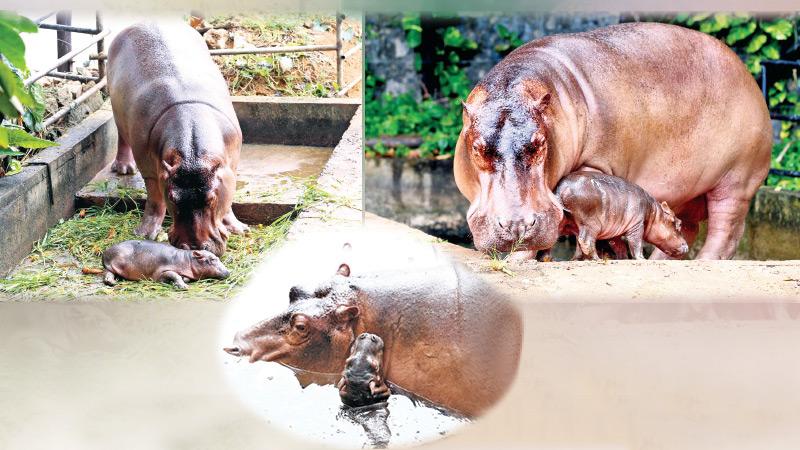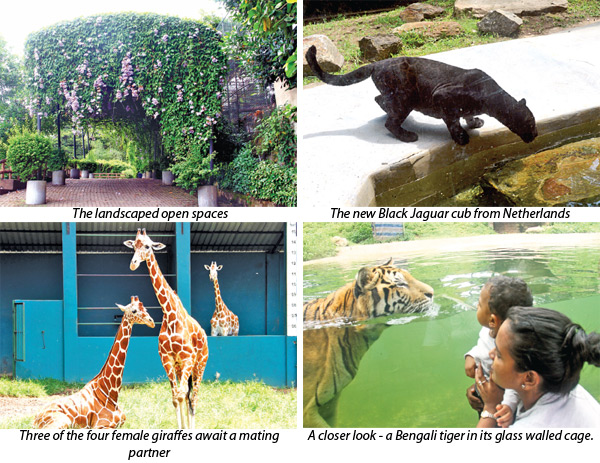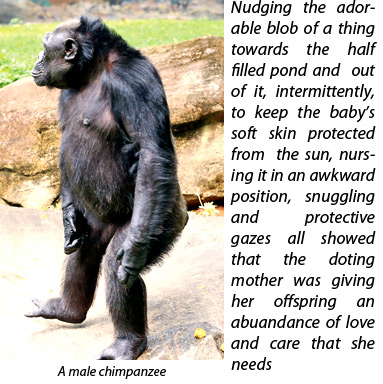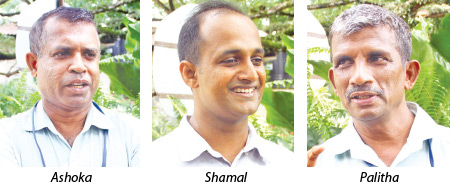
A mother who has gone through the pains of bringing forth a child will vouch that raising a child is no mean feat, even if the mother is a cantankerous herbivore. And if the baby in question weighs 100 pounds with mama nothing less than 3,000 pounds, do you think the job will be any easier?
 Cantankerous or otherwise, a mother is a mother. Her outpouring affection for the fragile calf which was just two-weeks-old when we visited the duo at the Dehiwela Zoo last week, was too much to bear.
Cantankerous or otherwise, a mother is a mother. Her outpouring affection for the fragile calf which was just two-weeks-old when we visited the duo at the Dehiwela Zoo last week, was too much to bear.
Nudging the adorable blob of a thing towards the half filled pond and out of it, intermittently, to keep the baby’s soft skin protected from the sun, nursing it in an awkward position, snuggling and protective gazes all showed that the doting mother was giving her offspring an abuandance of love and care that she needs.
Nella and her baby duo are among the hundreds of other reasons for visitors - children as well as the young-at-heart, to visit the Zoological Gardens, Dehiwela, during the August school holidays.
Assistant Curator of the Zoo, Palitha Perera said the parents of the Hippo calf arrived in Sri Lanka from the Prague zoo in November 2012 on an animal exchange program. In return for two elephants from Sri Lanka, the Prague Zoo donated the Nile Hippo pair, a pair of Comodo dragons and two wild horses.
Jealous eye
 This baby born to Nella and Hubert on July 24, 2019 is just over two weeks old now. While she doted on her newborn, Nella’s first offspring who is now four-and- a half years old, kept a jealous eye on her mum fondling the little sibling. The loving mum doted on her first born until she was ready to give birth the second time. So her jealousy was understandable. A hippo calf would continue to nurse on her mother for about two years and will be by her mother for 3-4 years.
This baby born to Nella and Hubert on July 24, 2019 is just over two weeks old now. While she doted on her newborn, Nella’s first offspring who is now four-and- a half years old, kept a jealous eye on her mum fondling the little sibling. The loving mum doted on her first born until she was ready to give birth the second time. So her jealousy was understandable. A hippo calf would continue to nurse on her mother for about two years and will be by her mother for 3-4 years.
But days before she gave birth, Nella started to behave aggressively. The Assistant Curator said she would have been worried about the baby with two giant Hippos roaming about the enclosure. Jealousy among animals is no different to humans’, it could mean even death for the newborn.
Therefore the Zoo keepers erected a temporary fence in the Hippo enclosure using iron poles to separate the pregnant mother and the other two. But it lasted only a few hours. “We had to secure the poles with cement concrete so that Hubert couldn’t pull it down,” Fernando said.
The Zoo officials also revealed another secret, Nella’s daughter was also pregnant around the same time as Nella. Her baby was born two days after Nella’s. A few days later the keepers found her baby unresponsive. They believe the calf may have been accidentally crushed by the inexperienced mother despite the fact that there were two keepers on night watch after the babies were born.
They were extra careful this time since a Hippo mum some years ago rejected her babies and killed the first born before the keepers could realize what she was doing. The next two babies born to her were bottle fed and raised by the keepers.
 “We had to extract the first milk (colostrum) from the unruly mother for over a week and we were awake in the night because the calf needed to be fed every two hours,” a keeper said.
“We had to extract the first milk (colostrum) from the unruly mother for over a week and we were awake in the night because the calf needed to be fed every two hours,” a keeper said.
It is not an easy job to ensure animal mums go through a safe pre-natal phase and a safe delivery in a zoo environment.
The Assistant Curator said for Nella’s baby the danger phase was over now, although the baby is still wobbly on her four tiny feet.
“If the animals are breeding it is a sign that the conditions for them at the shed inclusive of nutrition and the environment are nearly perfect – and also they are not under stress,” he added.
Black rhinos
The pair of black rhinos at the Zoo also gave birth to a female baby five years ago. With only 5000 black rhinos surviving in the world (IUCN – 2016), they are in the top of the endangered species list.
The couple brought down from a Japanese Zoo is a proud addition to the Dehiwela zoo. “We had to matchmake and get them interested in each other,” said Curator Ashoka Jayalath in lighter vein, explaining how much human effort went into getting the animals to mate. It had not been easy since the mother was born wild and the father was born and raised in a zoo. They are named after the two elephants - Kosala and Anula - which went to Japan in exchange for the rhinos. Mihiri is their teenage daughter.
The special diet for rhinos include a pulp made of king coconut, barley water and herbivore pellets as well as fruits, vegetables and grass.
In another corner of the zoo, four young female giraffes had been waiting for a mating partner for a long time. Development Officer, Education Unit - Shamal Samaranayake said the issue they face in bringing down a giraffe is its unusual height. “We always freight our animals in aircrafts. Once, we were very close to getting down a pair from Japan but by the time paper work finished the calves had outgrown the freight size,” he said laughing and added that however, they have not given up hope. The process is still on to fulfill the hopes of the four-girls-in waiting.
In spite of many rare, exotic and foreign breeds needing special attention, the most expensive of all to maintain is the herd of Sri Lankan elephants according to Zoo staff. The TOC grass (what milk cows are fed) that they feast on is specially grown on the Gonapola Farm. In addition, they are fed coconut and kithul leaves. “They waste more and eat less,” Samaranayake said.
Elephant enclosure
He was taking us on a tour of the open elephant enclosure and viewing gallery, one of the new features at the Dehiwela Zoo.
There we saw the elephants serenely having their morning dip in two large ponds, with the playful tips of their long trunks dancing above the water’s surface.
Among other additions at the Dehiwela Zoo are an upgraded kids play area, nicely maintained gardens and landscaped open spaces for visitors to relax and have a good time.
In some places development work was in progress. We learnt that soon the Hippo family is to get a modern enclosure with glass walled pond and a water filtering facility.
Besides the physical attractions, a two-year-old black jaguar, a gift from a Netherlands zoo was brought down last June and is still getting used to its new environment. The jaguar cub is housed next to a young tiger which is exactly the same age.
Among the animals to arrive soon for Dehiwela and the Rideegama safari zoo are two more black jaguars, four giraffes, two cheetahs, grey kangaroos and primates.
“Come and be with the wildlife”, the Development Officer invited visitors to strictly follow rules. “But don’t get carried away and feed the animals,” he warned since their gesture of love could even kill the poor animals.
(Our special thanks to National Zoological Gardens DG Dhammika Malsinghe and Deputy Director Anoma Priyadharshani.)
